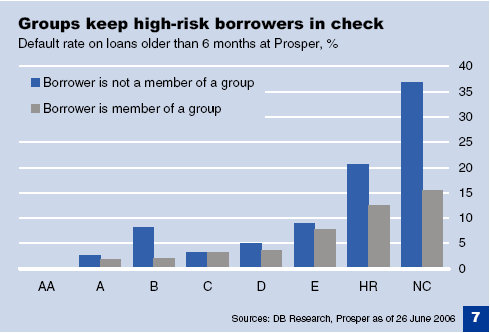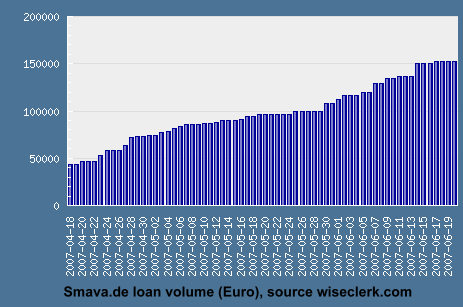Deutsche Bank research published a new 4 page report giving a good summary on the state of p2p lending. The report mentions Prosper, Zopa, Smava, Kiva and Boober. (Found through Marketingfacts.nl)

Deutsche Bank research published a new 4 page report giving a good summary on the state of p2p lending. The report mentions Prosper, Zopa, Smava, Kiva and Boober. (Found through Marketingfacts.nl)

Dutch p2p lending service Boober.nl changed the rules last week. Lenders are now restricted to a maximum investment sum of 39000 Euro. Boober told users that this step confirms that Boober is a platform for individuals and not for professionals or companies. It is believed that this step was neccessary due to regulation.
German Smava has restricted lenders to a maximum of 25000 Euros since the start. This too, is a precaution, since under German regulation professional lending without a license is not allowed.
Today I will take a look at the communication approaches of Prosper, Lendingclub, Zopa and Smava. Since it is hard to judge the individual customer support these companies offer, the focus of this post is on the mass communication channels. To communicate their services to the lenders and borrowers the services can use the website's FAQ/tutorials, a forum, blog(s) and newsletter(s).
Prosper.com
Prosper has very detailed FAQs, which leave no aspect open. There are tutorials, videos and webinars. The Prosper forums are very active. While Prosper announce changes to the service in detail (here), the policy usually seems not to comment on individual users questions (except for the bug report section). Prosper seems to rely on users to communicate and educate each other in the forums. There has been criticism about censorship and deleted posts in the forums which led some users to set up an prosper independent forum.
As far as I can tell Prosper has no blog of its own, but there is a personal blog of the CTO John Witchel. But it is not very active and will probably not be found by the average Prosper user.
Zopa
The Zopa FAQs are detailed, too. The Zopa Forum is quite active with Zopa staff members responding to posts and questions. Zopa has a company blog which has a leisurely tone and often is offtopic. In my opinion it could get more informative for lenders or borrowers.
The same applies to the newsletters Zopa sends out.
Smava
Smava maintains a very detailed and good FAQ. The Smava forum is pretty quite, but Smava staff usually is responsive to user questions. There is no blog. Smava is only 3 month old and so far there have been only 2 or 3 newsletters, which were mainly a summary of developments.
Lendingclub
Lendingclub communicates very different from the others. Mainly it relies on it's blog which is in fact directly on the Lendingclub.com homepage. The blog is very active with up to 2 or 3 posts per day. Not only does it explain details of the lendingclub service but also has general advice on personal finance, e.g. on obtaining and maintaining good credit. Lendingclub has lots of guest authors contributing to the blog. The FAQ are somewhat hidden and only available to logged in users (unless you know the direct link). The information, when located, is detailed (e.g. states). As far as I am aware there is no Lendingclub forum.
My impression is that Prosper and Smava communicate in a style that appears more corporate and 'old fashioned' always pondering what information can be released and what for. Prosper has occasionaly received rather aggresive feedback of users, citing them of being non-responsive to the wishes of their users. Zopa has a more buddying tone – hey take it easy. Lendingclub sounds educational to borrowers, aiming to help them by supplying them information. On the other hand Lendingclub's approach seems a little marketing driven, because their approach gains them search engine and blog visibility.
Infatuation with blogs, the rise of citizen newspapers (like Rue89) [FR], the rebirth of consumer associations (Que Choisir) [FR] or equally the expansion of BarCamps (BarCampBank was born in France) change deeply the relationship between French banks and their customers.
This new ecosystem gives more power to customers. The French Internet users have more technical solutions to run mortgage simulations or to compare the different offers on a loan.
Outside of France, new online services have already appeared where online lenders and borrowers can meet. These cyberbanks or P2P Banks (peer-to-peer or people-to-people) grow their success on lower rates and quicker processes. Following Zopa in the UK and Prosper in the US, P2P Banks have expanded in Europe with Boober in the Netherlands, Smava in Germany.
The reason for this is quite simple: traditional banks give a credit only to people with an excellent solvency profile; cyberbanks on the contrary lend to borrowers with good, or even mediocre profiles. And the average default on repayment has been lower than the bank-industry, so far. How do they achieve this ? Emulating auction sites like eBay, the borrowers and lenders assign scores to each other. Thus each participant has a strong incentive to uphold his commitment in order to keep a good score and to continue being part of the system.
For the time being, the development of P2P financial services in France meets 4 main points of resistance:
1. Banking regulation
The "Code monétaire et financier" (General Principles of Bank Regulation) is straightforward: "anyone except a chartered bank can perform banking operations in a regular fashion".
Nevertheless, nothing prohibits lending from an individual to another individual. Private individuals can lend on a personal basis to relatives or friends. These friendly loans can for example take the shape of a "Tontine" (a Rotating Savings and Credit Association).
Conversely, a bank is entitled to perform an activity relating to credit between individuals. But it is difficult to foresee the context where a bank would desintermediate itself and forgo handsome commissions…
2. Fear of over-indebtedness
The State, consumer associations, and consumers themselves live in fear of over-indebtedness. If credit for real estate is well accepted, credit for consumption purposes is much less widespread.
It should be noted however that French people are generally much less in debt than other Europeans and their situation does not logically support this fear (only 40% of people under 35 use the advantage of a cash credit, against of 70% in the UK). Some observers even regret the low penetration of consumer credit in France on the ground that economic studies show that it has a positive impact on growth.
3. A credit rate market that is both regulated by the state AND ultra-competitive.
From a general standpoint, the French market is ultra-competitive and interest rates are generally lower (yes, believe it) than in other European countries (the mean rate for amortizable loans was at 6.54% during Q1 2007).
Nevertheless, interest rates compensating risks can not go over the usury rate limit, as defined [FR] by the State (for amortizable consumption loans: 8.93% effective rate for a sum over 1.524 euros). This usury rate is a strong impediment for banks that would like to lend to atypical borrowers: students with no banking history, independent workers or small entrepreneurs with irregular revenues.
Since they cannot lend at a higher interest rate, these banks are not ready to take those risks. According to a study from the French Senate, roughly 15% of the population fails to qualify for credit because of this regulation on the usury rate. Providing credit to this fringe of the population would be like going after the long tail of credit.
4. The absence of positive credit scoring
In France, only banks have access to a history of credit operations. The positive records (historic records of credit to be reimbursed by an individual) are illegal in France where only negative records (historical records on banking operation bans or payment incidents) can and must be used when according a credit. The latter are penalty records that can only be accessed by banks and those unfortunate enough to be referenced in these records!
It must also be considered that credit risks are idiosyncratic to each country (culturally and functionally different). It is then difficult for a foreign company to properly evaluate risk in the French context and offer a competitive – and profitable – product in a already over-served market. (Let's remember the failure of Egg in penetrating the French market).
Risks for the lenders under the current conditions are very significant and would justify a higher remuneration (impossible because of the regulation on usury rates), or that the new entrant company would use a statistical rating of credit risks (which would require either a commercial agreement with a French bank, or the development of a reputation scoring as yet unheard of in France).
Conclusion
Nevertheless, despite all these barriers, it is likely that such a service will come to life in France within the next 3 years (when the corresponding European directives have been written and agreed upon – e.g. the new SEPA regulation: Single Euro Payments Area); either introduced by national actors (existing banks or financial organizations); or by new entrants (possibly involving partnerships with banks).
Quite a conundrum, but an outcome bound to happen anyway !
Authors : Jean-Christophe Capelli [FR]; translation provided by Frederic Baud [EN]. (Jean-Christophe & Frederic are two of the BarCampBank [EN] co-founders).
It's been roughly 3 month since the launch of German p2p lending service Smava.de and I want to do a short résumé on the results so far. One huge achievement is that all borrowers made their first payment on time – no lates so far. While it certainly is to early for conclusions, since only one payment cycle (first repayment in the beginning of June) has taken place, the outlook for Smava concerning low default rates is very good. Looks like Smava will be much nearer to Zopa then to Prosper in this point.
Smava has a very restrictive approach for admitting borrowers and loan applications. Not only does Smava verify identity, credit score and income documentation – it goes one step further and calculates if the borrower's financial situation is well enough to allow repayment of the desired loan sum. Only after completions of all these checks is the borrower allowed to publish is loan listing.
As a result the majority of borrowers (about 70 to 80 percent of all applicants) are declined from using Smava. While this strict validation is good for quality it does slow the growth of Smava.
Since the launch Smava enjoyed large and positive press coverage (newspapers, magazines, TV, internet). Despite the good PR, Smava funded only about 50 loans with a loan volume of about 150000 Euro in the first 3 month. There are enough lenders – Smava lacks borrowers. The low volume contrasts sharply from the figures Boober.nl achieved in the Dutch market (see previous post)

The majority of loan listings that were published did get funded. Smava has two interesting functions that are unique and not used on other p2p lending services:
Smava has yet to find a good concept for groups. While there are groups their purpose is yet to be defined. Consequently the majority of borrowers did not bother to join a group.
I will continue post updates on the development of Smava here on P2P-Banking.com.
German p2p lending service Smava succeded in raising another 4 million Euro VC from Earlybird after previous cash inflow from private investors was announced just weeks ago. (Source: P2P-Kredite.com blog)